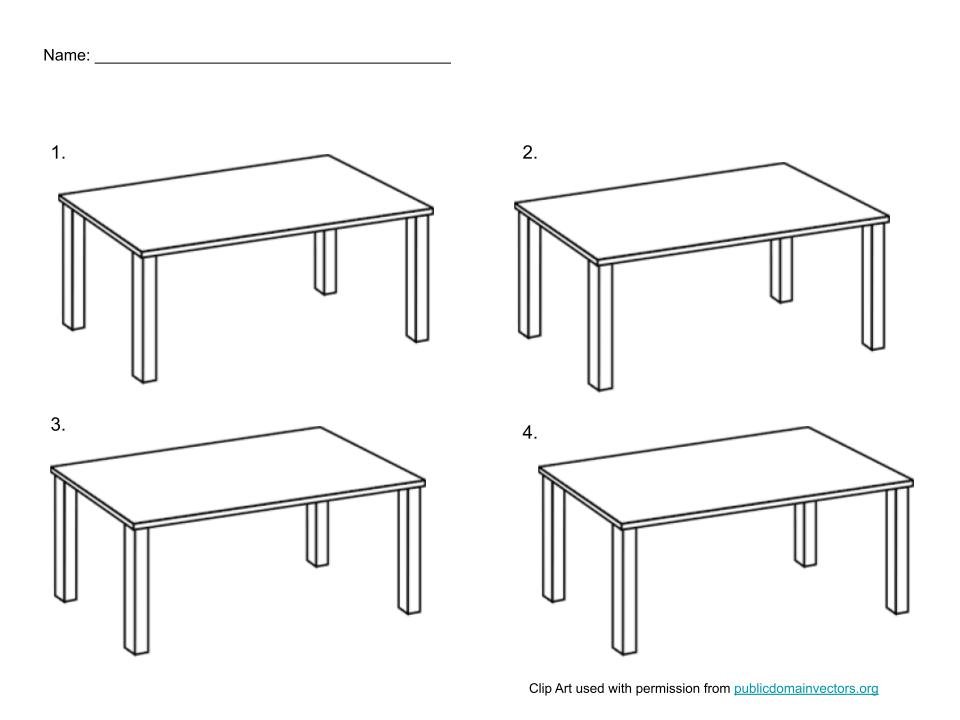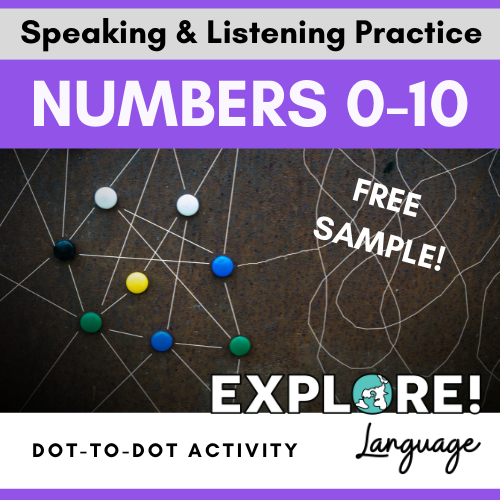5 speaking activities to captivate your students
Low-prep, high-interest activities for creative speech
I’m always looking for ideas to keep my class fresh and engaging, use the target-language, and maintain my own prep and grading load. Here are a few of my favorite speaking activities to use with novice and intermediate learners.
Activity 1: Table drawings for speaking and listening practice (for any level language learner)
This is a super-fun activity that works at any level. It takes almost no prep! Just take a few moments to draw objects on, around, and under table 1 which you’ll describe to your students in the target language. You can make your table drawing as simple or as complex as you like, using details like numbers, sizes, colors, and other descriptive vocabulary.
Step 1: Distribute this handout with clip art of four tables. In the target language, describe the objects you drew on, around, and under your table. Students will listen and try to replicate your drawing on their own table 1. After describing your table drawing a few times, reveal it to the class so they can check their work.
Step 2: Invite students to decorate table 2 with objects they can describe.
Step 3: Each student will describe their own table 2 to a partner while the partner draws on table 3; then switch roles. Repeat with another partner on table. 4.
At the end of this activity, students will have practiced descriptive speaking twice and listening three times. Kids love trying to outdo their classmates by drawing a unique, surprising table!
Activity 2: Name Three Game (for any level language learner)
Kids must list three items that fit the given prompt. This activity helps kids think about categories and connections within language. Here are a few prompts:
For novice speakers:
Name three supplies you need for math / science / PE / art / etc.
Tell 3 animals you would not want to have as a pet.
List 3 free things
Tell 3 things you would never do on vacation.
Tell 3 gifts you should never give your dad
What 3 things are you good at?
List 3 characteristics of (any celebrity)
List 3 things you want to do before you die
Tell 3 activities a teacher / athlete / doctor / stay at home mom / etc. does
Tell 3 things you like to do when it snows
Tell the 3 best parts of school
What are 3 chores you hate?
Name 3 items that are green / bigger than a desk / in your bedroom
What 3 items should never be green / bigger than a desk / in your living room?
What are 3 things you cannot buy in a store?
For intermediate speakers:
Name 3 reasons it would be nice to be a dog
Name 3 reasons sports team A is better than sports team B
Tell 3 reasons to not be a vegan.
Give 3 reasons to get in contact with your ex.
What 3 things would you if you became president / principal of the school
Tell 3 times it’s good to be in pain
List 3 urban legends or conspiracy theories
List 3 problems money can’t solve
List 3 reasons to get rid of your phone
List 3 signs that someone is interested in you
Tell 3 things you would do with your clone
List 3 things you didn’t learn in school
Tell 3 ways to get ‘likes’ on Instagram
List 3 reasons to be a teacher / doctor / any profession
List 3 qualities of a good class / a bad class
What are the 3 most annoying things parents do to their children?
There are a few ways to use these prompts.
Provide one prompt to the full class. Have partners discuss in the target language, then share with the full group.
Use a speed dating format. Give each student a different prompt, have them line up in two parallel lines facing a partner, and give them about 90 seconds to discuss both prompts. Then, one line moves a step forward to give everyone a new partner. Repeat. I love speed dating for giving kids a lot of practice in a quick-moving format. Incorporating physical movement is a bonus!
Post different prompts around the classroom or place them on tables. Allow kids to circulate throughout the room, discussing each prompt as they visit it. Kids have freedom to move and spend as much time as they like at each prompt, as long as they stay in the target language.
Activity 3: Superlatives for intermediate language learners
Use any of the formats above to discuss classroom superlatives in an intermediate class. Ask kids to name the classmate who fits each superlative, and to explain why.
Superlative Prompts
Who is most likely to be rich?
Who is most likely to go to Harvard? To go to ____ (any college)
Who is most likely to live in New York City? ____ (any city or country)
Who is most likely to own 30 cats?
Who is most likely to become a Spanish teacher? (any profession)
Who will become a parent first?
Who is most likely to be abducted by aliens?
Who will find a cure for cancer?
Who is the most faithful friend?
Who is most patient? (insert any positive personality trait)
Who will become a YouTuber?
Who will join the circus?
Who is most likely to marry a celebrity?
Who will go skydiving?
Who will survive the zombie apocalypse?
Superlatives are a lot of fun for upperclassmen who know each other well, and in classes where kids have developed a positive sense of community. (Click here for ideas on how to facilitate a positive classroom community).
Activity 4: Taboo (for novice or intermediate language learners)
Taboo is a party game where players must use definitions, descriptions, and examples to describe an unknown word to their team. I like to modify this game for language learners by having kids describe current vocabulary to their teammates.
I like using taboo with novice students who are mastering descriptive vocabulary. It’s also a good activity for reviewing level 1 & 2 vocabulary with upper levels and helping them become more comfortable negotiating meaning.
Step 1: Cut apart your vocabulary list and give one list to each group.
Step 2: A student draws a word and gets their group to say that word by giving descriptions, definitions, and examples.
For example:
“You use this in math class” (a calculator?) “No, it’s made of plastic. It’s used for measuring.” (a ruler)
“This is the class where we read books and write essays” (English)
“This is a place where you swim. (a lake?) “No, it’s smaller than a lake. There is one at the high school.” (a pool)
“This is a place where we keep food.” (a cupboard?) No, it’s cold. (a refrigerator).
Step 3: Repeat with additional vocabulary words until all words have been described.
This activity provides opportunities to teach situational words like “for example”, “You use this to…” and category words like “This is a supply / a place where / a tool / etc.” Students may also benefit from direct instruction on using definitions, descriptions, and examples to circumlocute. For a deeper discussion of this skill, visit my blog post “4 activities for teaching circumlocution”.
Activity 5: Dot-to-dot number practice (for novice language learners)
Kids love these dot-to-dots with a twist: the numbers are randomly sequenced so students must listen and connect the dots as they are read aloud in the target language. To add speaking practice, pair students with complementary handouts and give each the number sequence for their partner’s dot-to-dot.
Download a free pair of 0-10 dot-to-dots, and see my entire collection on my Teachers Pay Teachers store.
Thanks to my amazing colleague, Shelby Cole, who helped me develop and refine this list of activities!
Do you have a favorite quick and easy speaking activity? Share in the comments!





